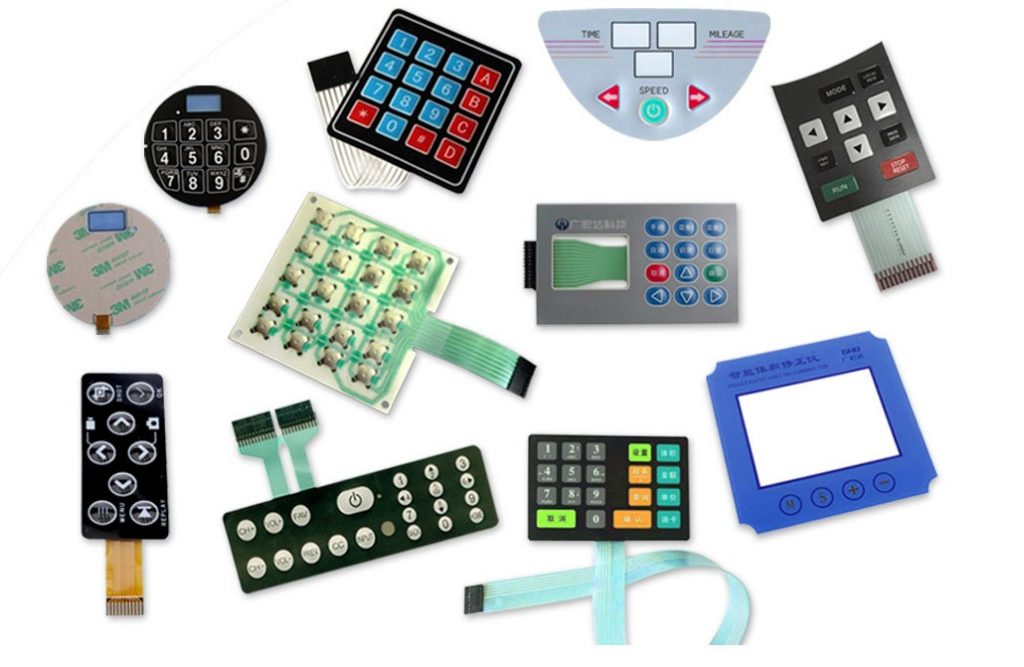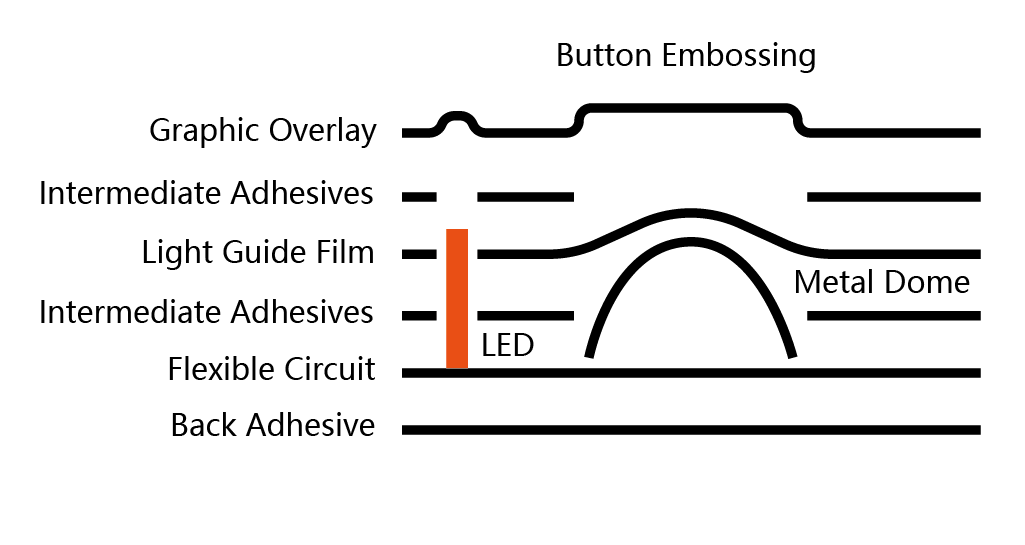The future of membrane switch in connected automotive systems
The Manufacturing Refine Behind Membrane Switch Over: What You Required to Know
The production procedure behind membrane layer switches combines cautious design, product selection, and quality assurance. It begins with recognizing the complexities of membrane layer switch layout and progresses via various phases, consisting of material selections and printing techniques. Each stage plays a vital duty in guaranteeing capability and sturdiness. Nonetheless, the complexities of layer building and construction and the rigorous testing criteria may expose understandings that are not instantly evident. What exists beyond these foundational aspects?
Recognizing Membrane Layer Switch Design
Membrane switches may appear basic at initial glimpse, their layout entails detailed factors to consider that guarantee functionality and resilience. The style process starts with a thorough understanding of user requirements, including the interface's desired application and ecological variables. Ergonomics is an essential aspect, as the layout must facilitate ease of usage while making certain that responsive feedback satisfies individual expectations.Moreover, the layering of elements, such as graphic overlays, sticky layers, and conductive traces, have to be precisely crafted. membrane switch. This split configuration not just influences the switch's responsiveness but also impacts its long life. Focus is offered to the sealing techniques employed to shield against moisture and dirt, which might compromise efficiency. Furthermore, style considerations encompass visual appeals, where color systems and aesthetic clarity boost individual experience. Eventually, the layout of membrane layer switches over equilibriums functionality, customer experience, and longevity, making sure that they meet the needs of different applications properly
Materials Made Use Of in Membrane Switch Production
When selecting products for membrane button production, it is necessary to consider both efficiency and sturdiness. The key materials consist of polyester and polycarbonate films, which give versatility and stamina. These movies are usually coated with adhesive to assure correct bonding to substrates. Conductive inks, usually composed of silver or carbon, are vital for creating electrical connections within the button, enabling reliable operation.Additionally, a protective layer, such as a tough layer, is often related to boost scratch resistance and durability. The selection of backing product, such as acrylic or foam, can significantly affect the button's tactile feeling and overall individual experience. In addition, various environmental variables, including temperature and moisture, need to lead material option to assure peak performance in certain applications. Ultimately, the best combination of materials adds to the membrane layer button's capability and life-span, making notified selections essential for producers.
The Printing Process: Creating Graphics and Text
The printing process in membrane switch production plays a considerable function in creating high-grade graphics and message. Numerous visuals style methods are utilized to assure aesthetic charm and performance, while cautious ink choice methods are vital for sturdiness and performance. Comprehending these components is basic for attaining ideal cause membrane switch layout.
Graphic Design Techniques
Graphic layout methods play a vital role in the printing procedure of membrane buttons, as they specify just how graphics and message will eventually show up on the last product. Efficient graphic layout involves the calculated usage of layouts, shades, and fonts to boost readability and visual appeal. Developers typically make use of vector graphics for scalability, making sure that images stay sharp at numerous sizes. In addition, interest to contrast and positioning is essential, as it influences individual communication and aesthetic high quality. The incorporation of branding aspects, such as logo designs, have to be managed with treatment to maintain brand name honesty. In general, thoughtful visuals layout methods add considerably to the performance and good looks of membrane switches, affecting customer experience and item performance.
Ink Option Methods
Choosing the proper ink is essential for achieving the preferred aesthetic top quality and durability in membrane layer button production. Various ink types are used, including solvent-based, water-based, and UV-curable inks. Each type uses unique characteristics, such as versatility, attachment, and resistance to environmental elements. Solvent-based inks are usually preferred for their resilience and dynamic colors, while water-based inks are a lot more eco friendly but may have constraints in attachment. UV-curable inks give rapid treating and durable efficiency. In addition, shade matching strategies ensure that the chosen inks align with design specifications. Ultimately, the choice of ink must consider variables such as application approach, substratum compatibility, and end-use requirements to achieve superior outcomes in membrane layer switch graphics and text.
Layer Construction and Setting Up
Product Option Refine
A careful selection of products is essential in the manufacturing process of basics membrane switches, as it directly influences functionality and resilience. The primary materials made use of consist of polyester, polycarbonate, and numerous conductive inks. Polyester is usually preferred for its superb resistance to chemicals and abrasion, making it ideal for rough settings. Polycarbonate, on the various other hand, gives premium clarity and impact resistance, which is advantageous for applications requiring visibility and effectiveness. Conductive inks, commonly made up of silver or carbon, are essential for producing trustworthy electrical paths. Furthermore, the selection of sticky products affects the general integrity of the button - membrane switch. Reviewing elements such as ecological direct exposure, responsive comments, and aesthetic needs overviews producers in selecting the most effective products for their specific applications
Layer Adhesion Strategies
Adhering layers in membrane button building is a vital procedure that ensures functionality her latest blog and long life. Various adhesion strategies are utilized to secure excellent bonding in between layers, which generally consist of the use of adhesives, warm, and pressure. Pressure-sensitive adhesives (PSAs) are generally used for their convenience of application and instant bonding capabilities. Furthermore, thermal bonding techniques can be used, where heat is utilized to trigger adhesive properties, protecting a solid bond. The option of attachment method mainly depends on the products entailed and the certain application requirements of the membrane layer switch. Appropriate placement and uniform application of adhesives are necessary to prevent flaws, safeguarding the switch operates efficiently throughout its desired lifespan.
Quality Assurance Actions
Guaranteeing high quality control throughout the layer building and construction and assembly of membrane switches is vital for keeping performance and integrity. This process typically includes several essential procedures, consisting of extensive examinations at each phase of production. Manufacturers use sophisticated screening approaches, such as peel examinations and attachment assessments, to verify the integrity of layer bonds. Additionally, visual evaluations are performed to recognize any kind of issues in printing or product inconsistencies. Environmental conditions, such as temperature and humidity, are carefully monitored to guarantee perfect curing and adhesion. Regular calibration of equipment aids keep exact manufacturing requirements. By executing these quality assurance measures, makers can significantly decrease the danger of product failing, assuring that the last membrane switches fulfill the needed specs and customer assumptions.
Checking and High Quality Control Measures

Advancements in Membrane Switch Over Innovation
As developments in technology remain to develop, membrane layer buttons are benefiting from cutting-edge advancements that improve their functionality and customer experience. One significant innovation is the assimilation of capacitive touch innovation, which enables more intuitive and responsive interface. This change not only boosts appearances however additionally decreases mechanical damage, prolonging the life-span of the switches.Additionally, developments in visuals overlay materials have brought about boosted sturdiness and resistance to ecological elements such as wetness and UV light. These products now use enhanced clearness and illumination, more elevating the aesthetic appeal.Furthermore, the consolidation of smart innovation is transforming membrane layer switches over into interactive control panels, making it possible for connectivity with IoT devices. This connectivity cultivates a smooth customer experience, paving the method for applications in different sectors, from healthcare to consumer electronics. Jointly, these technologies position membrane switches as important parts in modern-day device design.
Often Asked Concerns
For how long Does the Membrane Layer Switch Over Production Refine Take?
The period of the membrane layer button production procedure can differ considerably. Factors such as complexity, materials used, and production volume impact timelines, with regular manufacturing varying from a couple of days to numerous weeks for conclusion.
What Are the Usual Applications for Membrane Layer Switches?
Membrane switches are typically made use of in various sectors, including automobile controls, household appliances, medical tools, and consumer electronic devices (membrane switch). Their versatility and resilience make them perfect for applications requiring user-friendly user interfaces and reliable efficiency in varied atmospheres
Can Membrane Switches Be Customized for Certain Requirements?

What Is the Life expectancy of a Typical Membrane Layer Switch?
The life expectancy of a normal membrane layer switch differs, however generally, it varies from 1 to 5 million cycles. Variables such as use, setting, and material quality greatly influence toughness and total performance gradually.

Are Membrane Layer Changes Ecologically Friendly?
The environmental kindness of membrane changes differs. Some materials made use of might not be recyclable, while others can be environment-friendly. The general impact depends upon producing materials and techniques, requiring careful consideration throughout selection and disposal. The production procedure behind membrane layer changes combines mindful design, material choice, and top quality control. It starts with recognizing the ins and outs of membrane switch layout and advances through numerous phases, consisting of product choices and printing strategies. When choosing materials for membrane layer switch production, it is necessary to contemplate both performance and resilience. A cautious option of materials is important in the manufacturing process of membrane layer buttons, as it straight affects functionality and toughness. The selection of bond technique greatly depends on the products involved and the particular application demands of the membrane layer button.